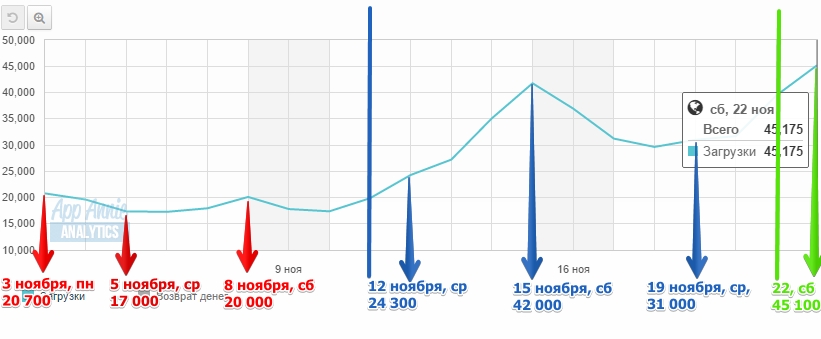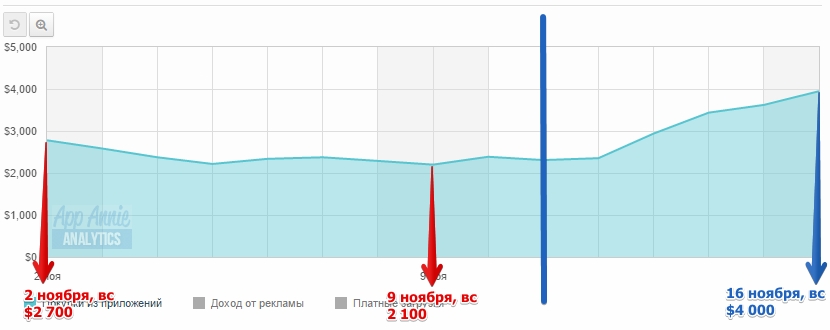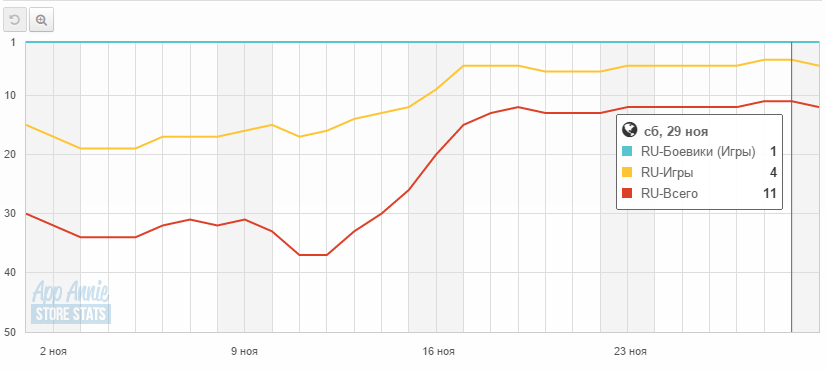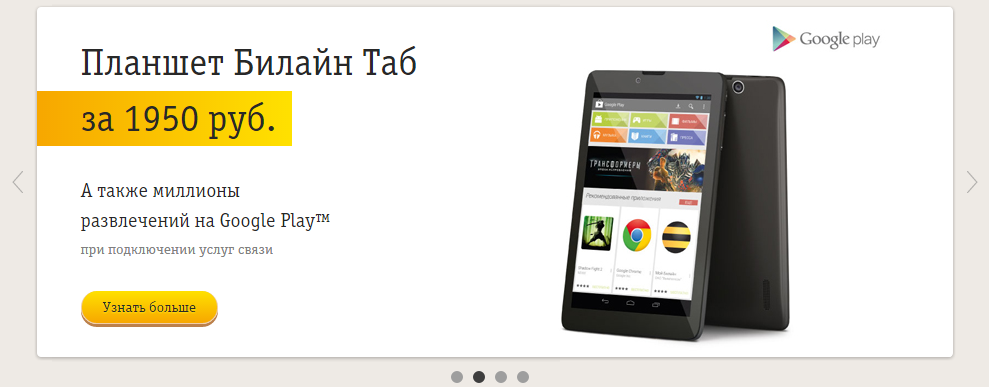How mobile game advertising on Russian television can affect downloads and revenue, App2Top.ru Sergey Babaev, Director of Business Development at Nekki, told us.
Introduction from the editorial board
Advertising games on TV and on tripwires in Russia has always been a curiosity, unlike in the West and even more so in the East. A few years ago, when domestic gaming journalists were just starting to actively travel around foreign countries, after trips they, as a rule, enthusiastically shared that, they say, Max Payne is advertised in the subway, GTA is on the street, and there are videos of any PS exclusives on television.
Now the games market, in general, of course, is different. It has grown far beyond the youth and geek communities, which, by the way, we have monetized (including due to widespread piracy) poorly. And Russia is one of the biggest players on it. Therefore, it is quite logical that game advertising appears on those sites that were previously occupied by products aimed primarily at the widest possible audience.
And we see it: their mobile games are advertised on Russian television, including Supercell and Mail.Ru Games. It is possible that in the future we will also see the sensational video Game of War starring Kate Upton.
But here another question arises: how effective is such advertising when we talk about the promotion of mobile games?
In Japan, this question was clearly answered by the successful experience of GungHo, which, after Puzzle & Dragons scored 3 million downloads, began promoting the game on TV, which significantly increased the positive dynamics of installations (from 2 million to 3 million downloads, the game grew 94 days, from 3 million to 4 million – 19 days).
With the companies Supercell, King and Machine Zone actively promoting their products on Western TV, the situation is a little different. This is an alternative to the burned-out global mobile inventory for them, access to a new audience. In other words, mobile is already completely theirs, and now they are trying to squeeze the most out of other sites.
But we are not in Asia, we are in Russia, and such companies, comparable in capacity to the above-mentioned ones, can be counted on the fingers of one hand, and there will still be fingers left. Hence the question arises: what will the promotion on non-digital platforms give to companies that have not yet burned out the mobile audience? The question is very relevant, given the constant increase in prices for mobile traffic.
We talked about this topic with Sergey Babaev, Director of Business Development at Nekki. The fact is that the guys recently launched a joint campaign with the mobile operator Beeline. In the promotional video of the Beeline Tab tablet, the Shadow Fight 2 genre is played out, as well as the gameplay is shown and the name of the game is mentioned. In addition, an advertisement for a tablet with a game icon appeared on billboards in Moscow.
The first question is not about the results, although, in fact, I would like to ask it first of all, but about how we managed to negotiate with Beeline?
Sergey Babaev
Beeline specifically promotes the Beeline TAB tablet, but experienced marketers on the operator’s side understand that such a device should be attractive, including as a gaming platform. Yes, not everyone will sit and play on their tablet, but such an opportunity is necessary. No one wants to lose functionality.
The event was originally conceived as a partnership between Beeline and Google. As far as I know, this partnership is quite old, I can’t go into history – with all my desire – I simply don’t know it. The guys discussed which projects could be suitable for integration into the commercial. Successful projects were considered, which are still in the top, with good incomes, etc. There are many successful domestic projects, and it was important to stand out among them. For my part, I often talked both in correspondence and during personal visits to Google’s Russian office about the specifics of the project, how it grows without investing in marketing, about the memorable style, animations and mechanics of the game. Probably, this is the starting point why one of these meetings brought up the conversation about participating in a joint advertising campaign.
If we don’t talk about a specific example, what do you think needs to be done so that the mobile operator will take up the promotion of the game?
There is no algorithm for how you can get on TV, billboards and YOUTUBE for free with a major partner. We are talking about a combination of factors and a number of features in communication that are almost impossible to formalize. I don’t think anyone other than Google or Beeline will be able to tell you more about the ways to get into such a promotion. From our side, these negotiations – from the initial idea to the nod to the final video – were carried out by me.
One thing I can say for sure: Google Play is friendly to everyone, and especially to those teams and projects whose cooperation is based on the Win-Win model. Respond to requests, participate in promotions, events, quickly and fully inform Russian managers (in particular, Dmitry Martynov) about the state of affairs in the project – and you will not be forgotten. I don’t know if TV advertising will be this bonus or not. But in any case, it will be cool.
The video turned out to be very successful, the game was organically entered into it, here is the main character, a boy who is a fan of films about martial arts, and a plot about a father-son competition. How closely did you work with Beeline on it? What did the process look like from your side in general?
The video was implemented by a creative agency hired by Beeline. The idea to make an original video, stylized as Shadow Fight 2, came right away. The theme of Kung Fu is close to all of us, and SF2 presents martial arts as we know them from Hollywood films. There is a complete coincidence of prerequisites and goals, which made it possible to make the final video so easy and unobtrusive.
After the first discussion, literally a few days were spent on the storyboard, which had to be approved and moved on. We were required to guarantee a quick response. There were no financial requirements for us, this event was absolutely free for us. Less than a month was allocated for the creation of the video, i.e. the start dates of TV advertising were already selected. I have committed myself to organize everything necessary with minimal delay: from feedback and providing sources (OST, cutting videos with fights, etc.) to legal papers (confirmation of age rating, rights to music, rights to the project, permission to show materials on TV and use in outdoor advertising, etc.).
Everything was very dynamic, in case of any questions – they called or wrote to me, told me what the catch was, and I already tried to solve the issue in a matter of hours according to my obligations. We had no moral right to let our partners down. The options to move something there, delay or leave for multi-day discussions were not considered. If you can’t communicate quickly with such partners, then it’s better not to get down to business at all. Only spoil the relationship… Obviously, we were able to do everything quickly, on time and efficiently.
Just like Beeline, that’s why the result is so pleasant, and the ideas and inserts of Shadow Fight 2 are implemented so harmoniously in it.
And so the video came out, now it has about 100 thousand views on YouTube (at least on the official Beeline page in the service), plus, more importantly, it was played on TV. What did it give in terms of downloads/revenue?
The first effect was from the start of TV advertising. I will not resort to superficial bright epithets, but just comment on the graphs taken straight from App Annie.
Let’s look at the period before advertising. This is the week from November 3rd to the 9th. Russia accounted for from 17 to 21 thousand installations (out of 140,000 total installations per day). Usually Monday is noticeably sagging, but in this case it is probably a residual effect from some collection. Otherwise, it can be seen that on Tuesday and Wednesday – installations fall, and then rise by Saturday – November 8. This is such a standard week that we have been observing for the past one and a half to two months.
Then the week begins from the 10th to the 16th. Monday is no longer distinguished by anything: it drops to 17 thousand. But somewhere from Tuesday evening, the TV campaign began. The graph shows that already on Wednesday there is not a drop, as usual, but a sharp increase – up to 24,300 installations. The next day, this number only grew and, finally, on Saturday, November 15th, it reached the mark of 42,000.
Next comes the week from November 17th to the 23rd. It can be seen that the growth of installations is systematic, the schedule repeats the dynamics of the distribution of installations by days, familiar to the project, only the number of installations itself has increased by 2 times and there are no sharp abnormal failures. But on the 21st, the promotion of the video on Youtube begins and on Saturday there were already 45,100 installations.
By the way, last Saturday the number of installations has already exceeded 50 thousand, so the growth of the video on Youtube gives a noticeable bonus, although the main role was played by TV advertising.
Perhaps it will be more convenient for someone to track the dynamics in this form:
Of course, not only Android users see ads, so the growth has also affected the App Store. On average, the increase is the same – by 2 times, but the scale is somewhat different: 4 thousand downloads per day in Russia turned into 8-9 thousand.
I think this growth will continue for several months, and we will get an additional 2.5 – 3 million installations, if not more. I don’t have exact information about how long an active advertising campaign on TV will last, so the estimates are approximate. On Youtube, the video has already exceeded 100,000 and, judging by the Beeline channel, it will gain at least a couple of million views. At least, all the cool and popular videos of the operator are spinning near this mark. I think our last joint video is at least as good.
As for revenue, below is an interesting graph from App Annie:
Incomes in Russia have reached a plateau. It is even noticeable that they were slowly declining (the launch and worldwide release of the project were quite a long time ago). On Sunday, November 9th, the income dropped to almost $2,000 a day, but in a week with advertising it grew to $4,000 and continues to spin in this range. If you calculate the income from new users by eye (without unscrewing advertising), then this is plus $ 1.5 – 2 thousand per day. The impact on the App Store is slightly less – the increase is about $800 per day.
If you make a forecast for a month, then, on average, $75,000 will come out. At the current dollar exchange rate, this is more than 3.5 million rubles per month. Considering that this is only an additional income of one of the countries, it sounds very nice.
To calculate money, of course, it is better to use more scientific methods, but when a plateau is noticeable on the chart and there is a fixed event causing growth, everything is more or less obvious.
It warms the soul and improves the rating. If I’m not mistaken, everyone can look at this information in App Annie and analyze it, so I’ll skip the long descriptive part and give a screenshot:
By the way, you probably have information on which channels and at what time the advertisement was shown. Can you share it?
You’ll be surprised, but I don’t have a complete list. I know that they saw it on the STS and somewhere else, but I was so wrapped up that I didn’t ask for detailed information about the channels and broadcasting time. They wrote to me on FB that they found the video without any problems: you can safely move away from the TV and wait until the familiar oriental music starts playing.
Here you have just revealed such, to put it mildly, a serious push from video advertising. Do you think if you shot the video yourself, would you buy airtime – would the expenses pay off? And would it be a more profitable venture than buying mobile traffic? And if there was no mention of Beeline, would the video have played as effectively?
If you take a certain ideal CPI for Google Play in the Russian Federation, then it will probably be 70 cents (I take personal tests and surveys advertised through the new mobile VK, but I do not pretend to detailed knowledge of the prices of all stores in all countries). An attempt to buy from 14 to 25 thousand installations – optimistically (I’m afraid, overly optimistic) would cost us from $9,800 to $17,500 per day. This is if you do not take into account the burnout of the source, the increase in cost long before the necessary unscrewing, etc.
I would not advise small teams that have traffic problems to invest in TV advertising as a way to save money. You will have to spend on creativity from experienced advertisers (who in our case were able to harmoniously fit so much information in 28 seconds). It’s not worth doing it anyhow, “if only my game was shown on TV” – that is, there are a lot of pitfalls, which, coupled with inexperience, can only come out more expensive to you and end up with certain reputational damage.
But for medium-sized studios and large TV companies, advertising can be very useful. We aim to experiment with it further.
By the way, you also have billboards. You have already mentioned in our Facebook correspondence that appearing on them is more of an image feature. As a business development director, could you tell us what she specifically gives or can give to the company?
It is quite difficult to assess the impact on the brand. At least until the release of the new part of the game, by which you can already understand the scale of the HYPE around the title. But it is also difficult to overestimate the mention of the project on the billboards of major cities of the country.
It is significant that in completely different stores (even in Windows Phone, where we recently finished) I met comments in the style of “I finally found this game from advertising”, “I saw this icon in the city and downloaded it”, etc. It is appropriate to talk about such a “finishing” effect. The user saw an advertisement on TV, he saw a video on Youtube before watching some kind of “letsplay”, and then Shadow Fight also catches up in real life, in the city. At the same time, all three channels provide information gently. It feels like the project is already everywhere, everyone is playing it, everyone knows it – I need to join in. As a result, recognition increases – it’s easier for the game to stand out in the TOP, because “I’ve seen this green bamboo and samurai shadows several times today – you need to download it!”
And the last question: will you advise other teams to go on TV now, and if so, at the same time, will you give a couple of tips on how to do it best?
As I have already said, for small teams or teams that have problems with marketing or project growth, I would not recommend grabbing TV as a salvation. I strongly recommend medium and large companies. Many people are already actively using TV, so I hardly discovered America with this.







